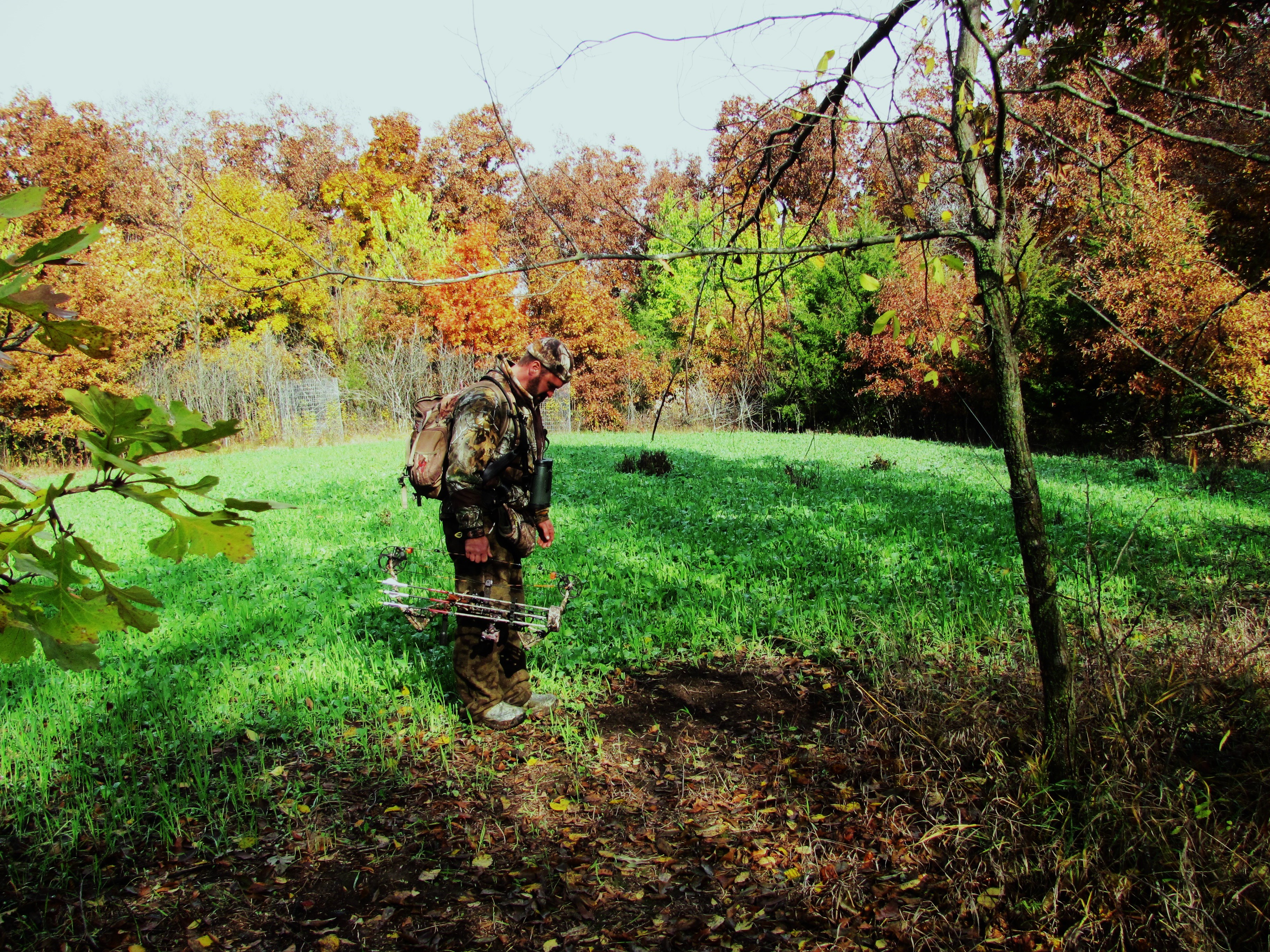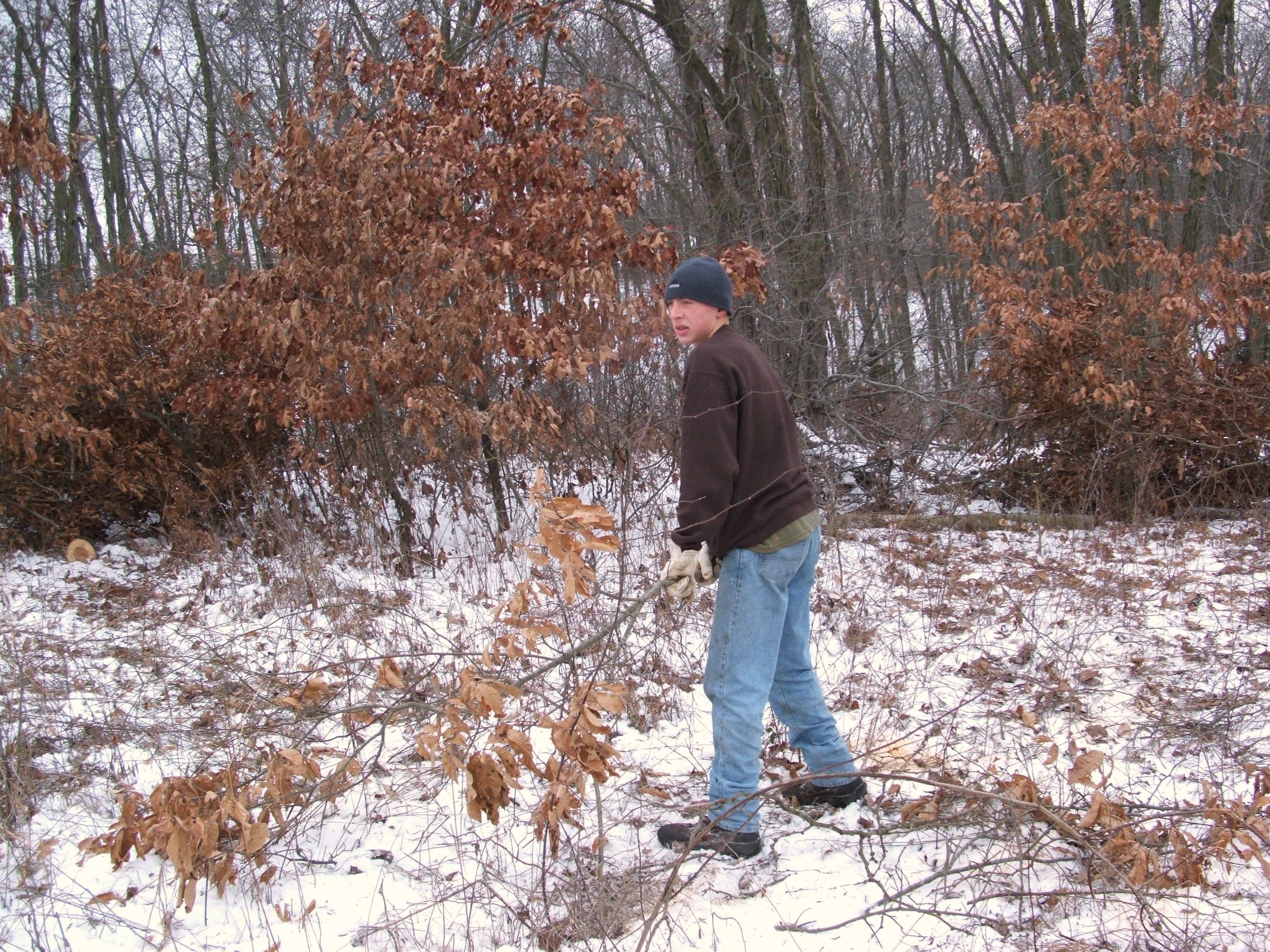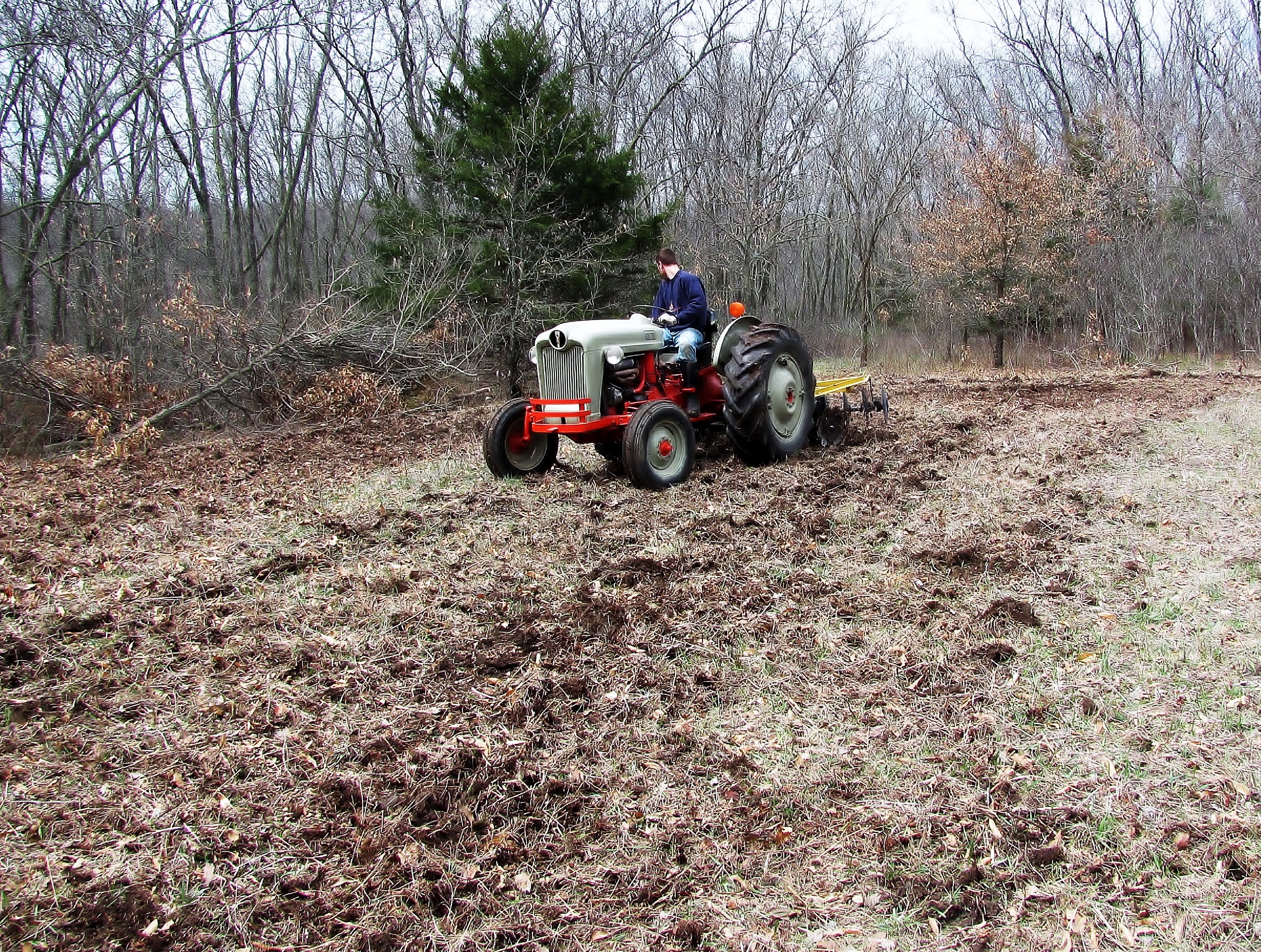February 2015 Interior Food Plots
The concept of Interior Food Plots for me was born out of desperation. I had leased a really nice farm with a good friend many years ago. It was a dairy farm and 100% of the tillable ground was farmed. Every nook and cranny of the farm’s open ground was planted in hay or a rotation of corn. Even the marginal ground was planted in erosion type grass blends and cut for the heifers. Each year, after the fall harvest was over and heavy frosts killed off the hay grounds, our hunting got harder and deer sightings would plummet. This was primarily because of our lack of food and the fact that surrounding land owners left crops standing for the deer. Neighboring hunters also had the opportunity to plant food plots of soybeans, corn, and other annuals. In essence, we had leased our way into getting access in an area that held good deer; but holding deer on our farm in late fall was very hard. We had to think of a way to provide more food through better habitat and food plots.
The only possible place left to plant food plots was in the timber. This wasn’t by choice of course but what we basically did was look for flat pieces of ground inside the timber void of mature trees. We picked several places that offered easy access with our ATV’s so that we could work the ground and get in some seed. There really wasn’t any planning or strategy that went into this. Not much thought or time was spent on picking the best locations. The spots we picked were clear spots in the timber over grown with brush or other small plants. In other words, the timber dictated to us where we were going to establish our food plots. We cleared out the areas, disced up the ground, and started planting Interior Food Plots. The lack of planning made their success limited at best!
I learned an awful lot about planting food plots inside the timber back then; and frankly I’m still learning. Interior Food Plots when planned for correctly become the local hang out for the local deer herd. When established in the right places deer simply can’t resist them. Bucks of all age classes use the areas around these plots as major areas of rubbing and scraping. Even mature bucks can’t resist their allure. It’s their location that makes them irresistible; their location that makes them a great place to hunt. Deer certainly feel more comfortable back in the timber compared to exposing themselves in open ground. Bucks, especially mature brutes, would much rather act out their roles during the rut inside the timber. Creating interior food plots sets the stage for this to occur.
Location
Back in the day, we planted interior plots in places that were easy or convenient to plant them. Natural clearings in the timber were the primary spots. But, the great thing about interior plots is that we can create them where we want them. We don’t have to pick natural openings in the forest…and we shouldn’t. This is where the planning kicks in. Because bucks of all age classes will use interior plots especially during the stages of the rut, we can create them to our advantage. Normally, when hunting Ag fields, funnels, or other features, the landscape dictates where and how we can hunt. Because interior plots are “man-made” we can locate them to our liking.
Whenever I hang a stand I’m always considering how to get to the stand…and how to leave them at the end of the hunt without bumping deer. One of the biggest draw backs of hunting food plots or Ag fields is getting down off stand and leaving at the end of the hunt. Small interior plots placed in the timber at our discretion give us the advantage. One ideal location is inside the timber 50 yards or so off the edge of an agriculture field or exterior food plot. The exterior food source will contain the primary and preferred food source like soybeans or alfalfa. The interior food plot acts as a staging area where the deer can nibble on green plants. Bucks can work sign posts like scrapes and rubs and then make their way out to the larger more exposed food sources at dusk. Normally, by quitting time, deer will have moved on making getting down and sneaking out easier. Planning for an exit route that does not take you past the Ag fields or food plots outside the timber makes for an excellent exit strategy. Creating a small lane leading from the interior plot to the outside food source in the direction you want the deer to leave creates an incentive for deer to travel where we want them to…and away from us so we can get down at the end of the hunt. On morning hunts, wait until just after day break to hunt this plot making sure deer have left the fields. I’ve witnessed more times than not that they will still swing by and visit this interior plot a few hours into the day.
Another great location for an interior plot is back in the timber away from other food sources…especially in blocks of bigger acreage. I’m talking a hundred yards or more from any open ground, preferably adjacent to thick cover. Ridge tops work great for this because they offer the most stable and constant winds. Because we are deciding the interior plots location, plan for security cover adjacent to the plot on one side and an exterior preferred food source on the other so that deer movement is across and in front of you. This way, deer will stay out in front of you and won’t have a chance to get down wind. Again, make sure access to the spot is perfect. You’re picking the spot, so plan entrance and exit routes before ever clearing a tree or planting a single seed. Planning is key! On morning hunts, sneak into the stand on windier days and stay all day during the rut. Deer will visit these plots all day. On an evening hunt plan your exit route so that you don’t bump deer that made it out to the Ag fields and bigger exterior food plots.

This interior plot is planted on a ridge top with great access from an adjacent cow pasture. Security cover nearby to the north and west offers great hunting with NW winds. The plot is planted in winter rye and appin turnips. A mock scrape tops off the deadly setup.
Planning is the key when locating interior food plots. Put them where you want them…don’t get lazy and put them where it’s convenient!
Land Clearing
In the January issue, I said the only thing you would need to create interior plots is a chain saw and a strong back. This is absolutely true. Once you’ve selected the ultimate site, clearing a small area to accept sun light is your next step. At this stage, you’ve picked the general area you want the plot. Now, pick the stand you’re going to hunt out of first before ever cutting a single tree. The stand site should be on the downwind side of the plot, or better yet utilizing a cross wind…for the wind you plan on hunting for this spot. I like to put my stands in a bigger tree if available with lots of cover like big oaks. If you can’t, consider hanging a few yards off the edge of the plot. Now, the works begins. Clear the ground by cutting off all brush, small trees, and bigger trees alike. Cut the trees as low to the ground as you can. As you begin to clear the ground, pile the brush and timber around the perimeter of the plot in areas you don’t want deer to use. I like funneling deer across and in front of me, this means piling the brush directly across from me and on my side of the food plot…this forces the deer to move in front of me in a left to right or right to left direction. Assuming your hunting with the wind in your face, this prevents most deer from even thinking about going down wind and it makes for easier shots as the deer are moving broadside in front of you. Other than those details, this is all about hard work and sweat. Use a tractor or wheeler to aid in removing the bigger trees if you have access to one. You absolutely don’t need to remove the stumps on trees you remove; just cut them as low to the ground as you can. When you are done clearing the ground for your interior plot, it’s not a bad idea to mow the area with a brush mower or burn the area off (ONLY burn if you know what you are doing and have adequate help).

When clearing for the interior plot, clear away all brush and trees cutting them off as low to the ground as you can. Pile the brush around the perimeter of the plot in areas you don’t want the deer to travel. There is no need to remove stumps if using a disc to work the ground in the months to come.
Shape and Size
Interior food plots don’t need to be big. In fact, keeping them relatively small makes them easier to hunt and establish. If your effective range with a bow is 35 yards, you should make the plot considering this limitation. If you want the plot to be slightly bigger, consider making it longer and narrow so that deer moving through the plot still come within range. A 35 yard by 35 yard interior plot is pretty good…I prefer slightly larger plots that are say 35 yards by 70 yards but probably not any bigger. This allows for some good plant growth while maintaining your ability to cover the plot. Experiment with L or hour glass shaped plots when it fits the terrain in the area you are creating. I said pick the spot first, but once you have the spot picked out avoiding giant trees or trees with good timber value is just the obvious choice.

Interior plots that cut back into the timber offer hunters with a man-made area to ambush deer. Locate the plots where you can enter and exit them without getting busted. Bucks of all age classes will visit these plots during all times of the day.
Planting Methods and Plant Varieties
I recommend establishing interior plots in the winter. I do this for several reasons. First, any downed trees with buds create an instant food source for wintering deer. Second, doing this very evasive work is best done as far away from hunting season as possible. And third, it gets us ready for weed control in our newly established plot.
In the spring of the first year, till the ground using a disc harrow. If you’ve done your job and cut the stumps low to the ground the disc will ride up over any stump and you won’t have to go around them. By tilling the soil, you are actually promoting plant growth of weeds and other woody plants and vines. This is a good thing! In a month, you can come back after all the weeds are up and hit the plot hard with glysophate herbicide (roundup) killing all the plant growth. Normally a quart of glysophate per acre is adequate but the first year establishing interior plots you might have to use a mix twice that strength. Because these plots are small, hand sprayers work fine for this. You may have to spray this plot several times throughout the summer…just make sure you stay ahead of the weeds! If you have the time and would rather, going in and discing every few weeks work too, but I like using glysophate the first year.
As late summer approaches, you have a choice to make. You can choose to plant fall planted annual greens every year in this plot. Or, you can try to establish a perennial plot like clover. Either is fine. I usually go with fall planted annuals each year only because I’ve had better luck with them over clovers. If you plan on going with fall planted annuals each year you should target late summer around September 1st. I like a mix of winter rye and appin turnips. Winter rye is a prolific grower and soil nutrient scavenger; while appin turnips are a forage turnip variety with good frost tolerance. This easy combination is a good choice for interior plots. Plant at a rate of 50lbs/acre winter rye and 3lbs/acre appin turnips.
If you are planning on establishing a perennial plot of clover, target your planting a little earlier. The last weeks of August work great. Plant 35lbs/acre winter rye, 2lbs/acre appin turnips, and 10lbs/acre of a clover mix containing at least some white clovers. The winter rye and appin turnips will give you a great first year food plot. The clovers will germinate this fall and come up next spring and establish themselves choking out any potential weeds. Mowing the winter rye next spring when it reaches near maturity will kill it off leaving only the clover.
Interior food plots are best planted in green plants like brassicas, cereal grains like winter rye, and clovers. An annual planting is sometimes easier to grow and maintain. Planting them each year might seem like more work, but establishing interior plots with perennials like clover are sometimes hard to maintain especially when considering weed control.
The actual planting method is quite easy. If you’ve done your work, the plot is free of weeds and should be mostly barren ground. Disc the ground using your disc harrow or any other method you can to break up the ground exposing the dirt. Discing works best because the blades of a disc simply roll over stumps or roots that are common in food plots established in the timber. Broadcast your seed and fertilize. I like to use 200lbs/acre of triple 19 fertilizers on my interior plots each year…less nitrogen if on perennial clover plots. Once the seed and fertilizer is spread out, lightly disc in or drag in the seed. That’s it! You don’t need fancy seeders or anything else…bottom line is bust up the ground any way you can, spread the seed and fertilizer, and disc or drag in the seed.

A disc is the best implement to use with interior plots. The blades will ride up and over stumps and roots when breaking up the soil for seed bed preparation. This interior plot is being tilled the first year using a Ford 861 tractor and 6.5 foot 3 point disc. Notice the brush piled along the sides to deter deer from using those areas…pile the brush to promote deer to work across the plot in front of you.
In Review
These are the key points to take away from this tactic and habitat project: 1. Interior food plots are effective because we plant them where we want them. 2. Plots about a half-acre in size that you can shoot across are the best. 3. We are best served when establishing interior plots in the winter. 4. Green annual or perennials are the plants of choice. 5. Plan entrance and exit strategies before ever cutting a tree or planting a seed. 6. Planting methods need not be expensive or hard. 7. Stumps need not be pulled when tilling the ground with a disc. 8. The return on investment with interior food plots is very high. A one-time cost of a chain saw gets you well on your way. The habitat gets better and the hunting is made easier.
February-I will be doing maintenance on my interior plots that have already been established as well as planning out additions to the security cover on my farm. In March’s issue, I will be talking about creating security cover for deer and how to do it in conjunction with interior plots for some outstanding habitat improvement and hunting! In the April issue I will be planning the years food plots. I will go through a process of how to determine what plots are best for you and why.
